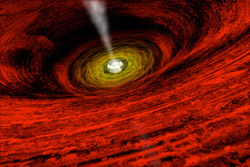Ring Around the Singularity

Despite what the movie The Lord of the Rings would have you believe, physicists may possess the ring to beat all rings. In the 11 March print issue of PRL, researchers propose that five dimensions of space-time can harbor a rotating, donut-shaped “black ring”–the first example of a nonspherical black hole. If we live in a world with extra, hidden dimensions–as many theorists speculate–these rings might even be created in Geneva, at the world’s largest particle accelerator, now under construction. Black holes have proved key in the past for checking and improving theories with higher dimensions, and the discovery strengthens the case that these objects obey different rules when lifted from their 4D confines.
Physicists go ga-ga over higher dimensions for one reason: string theory. This proposal for uniting all of nature’s forces dictates that particles are one-dimensional strings vibrating in a 10- or 11-dimensional space-time. All but four of these dimensions (three of space and one of time) would be too small for us to perceive directly. In the mid 1990s, theorists made a lot of progress pulling strings out of their normal context and meshing them into black holes in five large dimensions. Notably, researchers were able to accurately calculate the entropy of some of these ensembles and ultimately extended these results to four dimensions as well.
String theorists now have a new kind of black hole to study. Theorems from the 1970s proved that 4D black holes can only adopt a spherical shape and are uniquely defined by their mass and angular momentum. Until recently, most assumed these results would hold in higher dimensions as well. Last year, Roberto Emparan of CERN in Geneva and Harvey Reall of Queen Mary College in London found a ring-shaped black hole solution to Einstein’s equations in five dimensions [1]. But this static black ring would need a disk of exotic matter inside it to keep from collapsing. Now they’ve found that the centrifugal force of a spinning ring balances the pull of gravity all by itself. The authors speculate that a spherical black hole in five dimensions might morph into a black ring if spun fast enough.
Contrary to the 4D theorems, there is a range of mass and spin where either shape can exist, so these properties don’t uniquely determine the form of black holes in five dimensions. It still isn’t clear whether black rings will prove completely stable, Reall admits. But if they are, and if certain “large extra dimensions” scenarios are correct, these objects could be created in the most energetic collisions at the Large Hadron Collider, the new facility under construction at CERN, he says.
“This black ring solution is a remarkable discovery,” says Simon Ross of the University of Durham in the UK. “This was widely regarded as a relatively closed field, where the interesting discoveries had already been made.” Gary Horowitz of the University of California in Santa Barbara agrees and suspects that thicker rings–more like bagels than hula hoops–will prove stable. As for the future, he says, “[this result] opens up the possibility of a lot of new properties of black holes in higher dimensions.” Whether those will include bestowing the god-like powers of Tolkien’s ring remains to be seen.
–JR Minkel
JR Minkel is a freelance science writer in New York City.
References
- R. Emparan and H. S. Reall, Phys. Rev. D 65, 084025 (2002)


